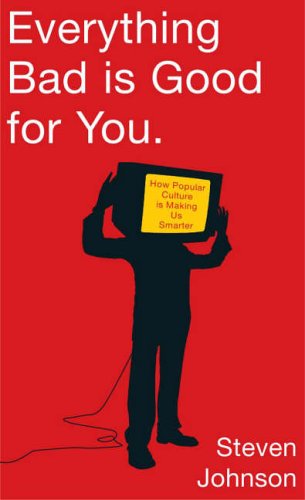
 We’ve been curious here how we can expand the use of our dome beyond presenter led real-time and pre-rendered shows. In these programs, the audience is being feed information while being for the most part, passive. After reading “Everything Bad is Good for You: How Today’s Popular Culture is Actually Making Us Smarter” by Steven Johnson, I’ve become much more interested in how the gaming model works and how we can utilize it. In a nutshell, Johnson explains that video games are popular because they put the user in complex situations and challenge them to figure something out, as opposed to a more traditional method of spoon feeding ideas. He also shows similarities to this in more complex TV storylines from shows such as Lost. These challenges and mysteries, once solved, give a sense of satisfaction and a better understanding of material to the viewer.
We’ve been curious here how we can expand the use of our dome beyond presenter led real-time and pre-rendered shows. In these programs, the audience is being feed information while being for the most part, passive. After reading “Everything Bad is Good for You: How Today’s Popular Culture is Actually Making Us Smarter” by Steven Johnson, I’ve become much more interested in how the gaming model works and how we can utilize it. In a nutshell, Johnson explains that video games are popular because they put the user in complex situations and challenge them to figure something out, as opposed to a more traditional method of spoon feeding ideas. He also shows similarities to this in more complex TV storylines from shows such as Lost. These challenges and mysteries, once solved, give a sense of satisfaction and a better understanding of material to the viewer.
We’ve been talking with Eric Knisley over at RENCI about experimenting with the Unity game engine on the dome and how we can extend the challenging gaming experience to some of our presentations. The difficulty, beyond technical issues, getting 200-300 people to play a game that is typically controlled by one person. People have experimented with IR and other techniques that have been sucessful for simple interactions. But maybe there are other ways to create presentations and even pre-rendered shows that really challenge the viewer to figure things out on a different level.

3 Responses to “Challenging the Viewer in the Dome”
Nicholas Hoffmann
I think this would be a fascinating way to engage the public and school groups in the dome experience.
I picture a live star show teaching about right ascension and declination. Teams of students work together to determine the right coordinates to observe a celestial events (meteor shower, or whatever!), and then tilt an accelerometer of some sort to “adjust” their latitude and location in time to view the event.
Or a long distance view of the sun, earth, and moon system. Each student has a sensor that relates its distance to a central point. Students would walk around the central point, acting as the moon orbiting the earth. The long distance view on the screen would reflect the positions of the students with numerous “apparent moons”. Each student could rotate and revolve around the central Earth, and observe how their moon changes its phase. The educator could challenge the whole group to have moons that are between half and 3rd quarter. It would be a kinda hi-tech Round and Round We Go.
These are just some first brainstorm thoughts I had. I’m a huge proponent of using video game style interactions to increase the hands-on aspects of material that is often intangible.
Jay Heinz
So it seems like things like that are more appropriate for small school groups – less than 10 or 15 people or even less – any bigger and it seems like it would be visual chaos on the screen.
For the accelerometer, it’d be fun to get a HUGE beach ball and put an accelerometer in the center of it (an iPod connected to bungee cords?). The kids could all touch it and spin it around until it was in the right place.
Nicholas Hoffmann
Yeah, my mind starts to balk at how to give 200-300 folks a sense of investment in any sort of dome-based game. But for school groups of the appropriate size, games can still give each students a more individual role.
Is it too early yet to unconsciously assume that any controller involved would be accelerometer/motion based? I’m sure there are other configurations of controllers – dual joysticks, etc. that could provide a way for students to manipulate objects on the dome screen.
Perhaps if the students each had their own set of headphones – as they used a controller to select an object on the dome, the headphones gave some pieces of information the students needed to know about the object. Or a joystick interface that controlled an onscreen rover – some students are involved in guiding the rover, and others in choosing the scientific tools it uses.
You can tell me to stop brainstorming at any time – I really do get excited about using games in this way.